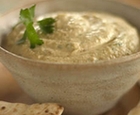|
Mid-East Appetizer Puréed Chickpeas You can buy very good commercial hummus, but this homemade version is excellent. Adapt it to your taste—use more or less lemon and garlic; add dill, hot pepper flakes, minced roasted peppers or olives. New York Times writer Jane Brody even adds a dollop of plain yogurt—it’s delicious!
Drain and simmer chickpeas for 30 minutes, just to make certain they're tender. Reserve cooking water. In a food processor, combine chickpeas with lemon juice, tahinii, and garlic. Blend to a smooth, creamy consistency. If you need more liquid, add a bit of the cooking water. Add salt to taste. Turn out into a bowl or platter. Create a small “crater” in the center and dribble with a little olive oil. Sprinkle with paprika and some finely chopped parsley. Serve with pita. * You can also use 1/2 lb. dried chick peas. Use Quick Soak method to prepare for cooking: cover peas with water, bring to a boil for 1 minute. Turn off heat and let sit for 1 hour. Then simmer for 30-45 minutes till tender. Or use Overnight Soak method: let peas sit overnight in a bowl, covered with water. Cook peas 30-45 minutes the next day till tender. |
Tips & Glossary Many of the ingredients used for Middle-Eastern cooking may not be in your spice shelf, but you can find them at Mid-Eastern food stores. So to avoid frustration, make a list of the items you need before trying out the recipes. Bulgur Wheat: wheat grains that have been par-boiled, dried, and de-branned. Bulgur has a high fiber content and wonderfully nutty flavor. Cardamom: related to ginger. Pods (green, brown, or black) are the best way to store the spice, although high-quality ground is readily available. A equivalency: 10 pods = 1½ tsp. ground cardamom. Coriander: aka cilantro, Chinese, or Mexican parsley. Fresh leaves and dried ground seeds are used in Mid-East, Asian, Indian, and Mexican cuisines. Cumin: related to parsley and carrot plant; an important ingredient in chili powder. Used especially in curries, but also in Mid-Eastern, Mexican and Asian dishes. Cumom has an earthy, peppery flavor. Deep Frying: oil must be hot enough; otherwise food will be soggy and greasy. Use a deep-fry thermometer to ensure proper temperature is reached. When cool, oil can be strained, refrigerated, and re-used. Filo: aka phyllo; paper-thin sheets of raw, unleavened flour dough. Purchase frozen in any grocery store and follow directions on package for thawing. When working with one sheet, keep others covered with a damp towel to prevent drying out. Rosewater: distilled from rose petals and used to flavor Mid-Eastern and Asian cooking. You can make your own—but why? Purchase it at Asian or Middle Eastern food stores. Semolina flour: made from hardy durum wheat. A yellowish flour, it's used in Asian and Mid-East cooking (couscous). In the U.S., it's Farina, a breakfast cereal. Tahini: paste from ground, hulled sesame seeds. A major ingredient in hummus and other Mid-Eastern and Asian foods, you can purchase at most grocery stores.
|
Site by BOOM
![]()
LitLovers © 2024

